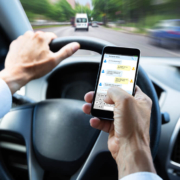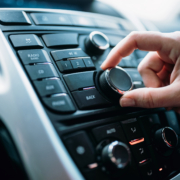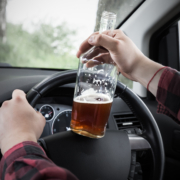What Percentage of Car Crashes Are Caused by Human Error?
Car accidents are a leading cause of injuries and fatalities across the United States, and the vast majority of these crashes are preventable. Studies consistently show that more than 90% of car crashes are caused by human error, with behaviors like distracted driving, speeding, and impaired decision-making leading the charge.
What Does Human Error in Car Crashes Mean?
Human error encompasses a wide range of behaviors, all of which boil down to poor decision-making or failure to act appropriately in a given driving situation. Some of the most common examples include:
- Distracted Driving: This is one of the most prevalent forms of human error. Activities like texting, eating, or using a GPS while driving divert attention from the road.
- Speeding: Driving faster than the posted limit or too quickly for weather or traffic conditions increases the likelihood of losing control.
- Impaired Driving: Alcohol, drugs, and even certain medications can impair judgment, slow reaction times, and reduce focus.
- Reckless or Aggressive Driving: Behaviors like tailgating, weaving through traffic, or road rage can cause serious accidents.
- Fatigue: Drowsy drivers have reduced reflexes and may even fall asleep behind the wheel, creating dangerous conditions.
Each of these factors plays a role in the high percentage of crashes attributed to human error. Unfortunately, the consequences of these mistakes often lead to life-altering injuries, fatalities, and significant financial burdens for victims.
Alabama’s Legal Landscape: How Human Error Shapes Accident Claims
In Alabama, the legal framework surrounding car accidents is significantly influenced by the state’s strict contributory negligence laws. These laws make it essential to establish clear fault when filing a claim, as even a small degree of responsibility can impact the outcome.
Key Legal Responsibilities for Alabama Drivers
Drivers in Alabama are legally required to:
- Follow Traffic Laws: This includes observing speed limits, obeying traffic signals, and yielding when required.
- Avoid Distractions: Alabama law prohibits texting while driving and engaging in any form of manual data entry on a handheld device while operating a vehicle.
- Drive Sober: A blood alcohol concentration (BAC) of 0.08% or higher is considered over the legal limit for drivers aged 21 and over.
- Maintain Vehicle Safety: Drivers must ensure their vehicles are in proper working condition to avoid mechanical failures that could lead to accidents.
Why Human Error Is the Leading Cause of Car Crashes
As mentioned earlier, human error is a factor in more than 90% of all car crashes. But why does human error dominate these statistics, and how does it impact drivers in Alabama specifically?
Distracted Driving in Alabama
Distracted driving is a major concern nationwide, but it’s particularly significant in Alabama, where accidents caused by texting or using a mobile device are rising. Common distractions include:
- Cell Phone Use: Texting, talking, or scrolling through social media while driving.
- Eating or Drinking: Grabbing a bite during your commute can divert your hands and focus from the wheel.
- Passengers: Conversations or disruptions caused by passengers can also lead to distraction.
Reckless Driving Behaviors
Drivers in Alabama often face issues like tailgating, speeding, and running red lights, especially on busy highways like I-65 and I-20. These behaviors are particularly dangerous in urban areas such as Birmingham or Montgomery, where traffic congestion increases collision risks.
Driving Under the Influence
In 2022, Alabama reported hundreds of alcohol-related crashes, underscoring the impact of impaired driving on accident rates. DUI offenses don’t just result in criminal penalties; they can also leave drivers liable for civil lawsuits if their actions cause harm.
The Role of Evidence in Proving Human Error in Alabama Car Crashes
When a car crash occurs, especially one caused by human error, gathering and presenting the right evidence is critical to building a strong case. In Alabama, where contributory negligence laws can bar recovery if a victim is even 1% at fault, robust evidence is often the deciding factor in securing fair compensation.
Key Types of Evidence in Car Accident Cases
Police Reports
After an accident, the responding officer will file a report documenting key details, such as the location of the crash, weather conditions, and statements from those involved. This report often includes the officer’s initial assessment of fault, which can be pivotal in proving liability.
Eyewitness Testimonies
Witnesses can provide an unbiased account of what happened, such as whether the at-fault driver was speeding, distracted, or running a red light. Collecting contact information for witnesses at the scene is crucial for later interviews.
Dashcam and Surveillance Footage
Many modern vehicles are equipped with dashcams, and nearby businesses or traffic lights may have surveillance cameras that captured the accident. This visual evidence can corroborate claims of negligence, such as reckless driving or failure to yield.
Photographic Evidence
Taking photos at the scene of the accident can document vehicle damage, skid marks, road conditions, and injuries. These images are invaluable in reconstructing the events leading to the crash.
Cellphone Records
In cases of distracted driving, cellphone records can reveal whether the at-fault driver was texting, making a call, or using a mobile app at the time of the collision.
Medical Records
Documenting injuries with prompt medical care is essential for establishing the extent of harm caused by the crash. Medical records link injuries directly to the accident and substantiate claims for compensation.
How Evidence Helps in Proving Negligence
Evidence is the foundation for demonstrating how the at-fault driver’s human error directly caused the accident. For instance:
- Distracted Driving: Text messages sent around the time of the crash can establish distraction.
- Speeding or Reckless Driving: Skid marks and damage analysis can indicate excessive speed.
- Impaired Driving: Breathalyzer results or prior DUI charges may confirm impairment.
Securing Evidence After a Car Crash in Alabama
In the immediate aftermath of an accident, taking proactive steps to gather evidence is critical:
- Call the police to ensure a report is filed.
- Take photos of the scene, vehicles, and injuries.
- Collect contact information for witnesses.
- Seek prompt medical attention, even if injuries seem minor.
By compiling this evidence early, you increase the likelihood of building a successful case against the at-fault party.
Haygood, Cleveland, Pierce, Thompson & Short, LLP: Protecting Your Rights After a Car Crash in Alabama
Human error is a significant factor in car accidents, but victims don’t have to navigate the aftermath alone. If you’ve been injured in a car crash in Alabama, the experienced attorneys at Haygood, Cleveland, Pierce, Thompson & Short, LLP can help you understand your rights and pursue the compensation you deserve. Contact us today for a free consultation and let us help you take the first step toward justice.










Leave a Reply
Want to join the discussion?Feel free to contribute!